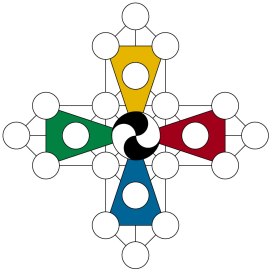Framing the Symmetrical Year
Humans are pretty ingenious. Not everyone all the time, but each of us has our moments, and collectively, we are genius. Part of my preoccupation with calendars is exactly this: they are an intersection of astronomy, mythology, history, genealogy, anthropology, sociology, human behaviour, cognition, symbolism and more working together in some combination.
There’s a progress in education where we move from learning about things and begin to learn things. Having learned about all these marvellous calendars, naturally, I had to make one. While this process is ongoing and non-linear, here are a few of the essential things to consider in building a calendar for yourself or your community.
In this case, the purpose is to develop a calendar that helps bring us back to the #NaturalTime of day, Moon, Seasons, year.
Symmetry, Synchrony, Serendipity
Our idea of time is based on the changes to the light across the great celestial expanse: the day and night, the waxing and waning of the Moon, the year from Winter to Summer. This is our earthly experience of the rotation of the Earth, the Moon’s orbit of the Earth, and the Earth-Moon’s orbit of the Sun, and our clock/calendar system creates a map of these motions: the clock maps the Earth’s rotation, the month maps the Moon’s orbit, and the year maps the Earth’s orbit.
If we’re going to reconsider how we frame our experience of time, then best to build up from the basics.
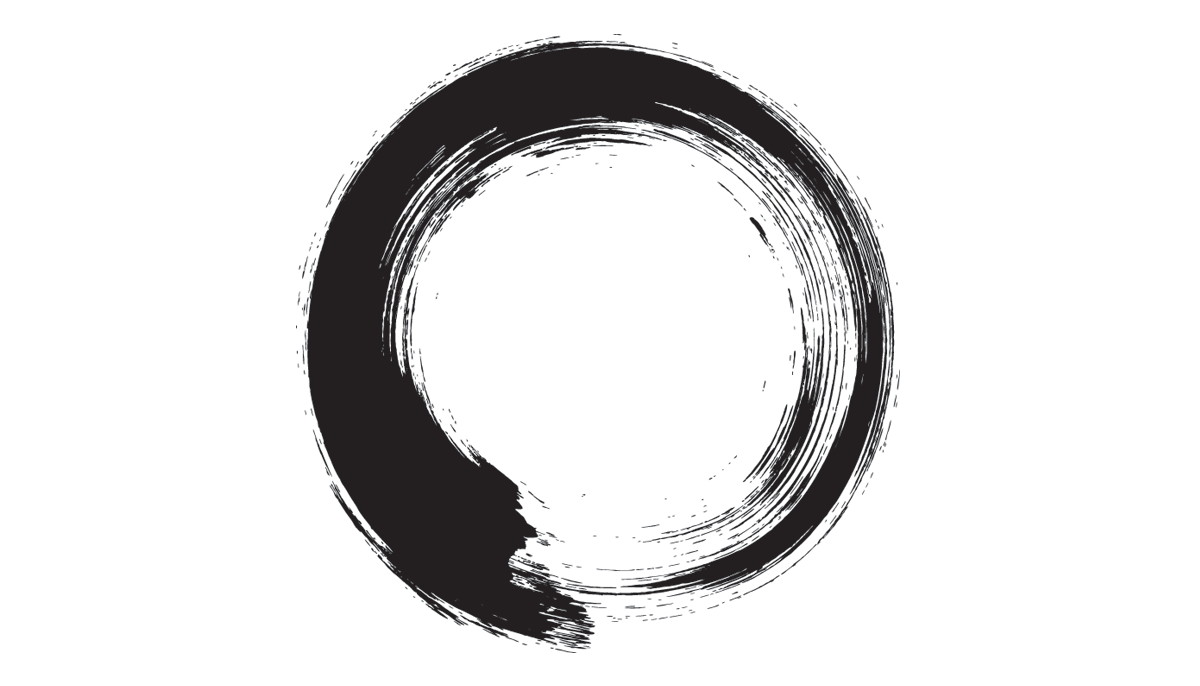
Light in the Dark
The rhythms of Natural Time are preexisting conditions for life on Earth, and as such, this is one thing we have in common with all of our ancestors going back to our Last Universal Ancestor some 3.5 billion years ago. We have disconnected our calendar and ourselves from this rhythm, severing a vital connection to the greater world. Let’s take a closer look at how these rhythms work, and see if we can’t rejoin the dance.
the Day throughout the Year
Daytime is the side of the Earth facing the Sun, nighttime is the side facing the Stars. I imagine it as a stationary grid of hours, minutes, seconds that enclosing the Earth, which rotates us through all the times of day.
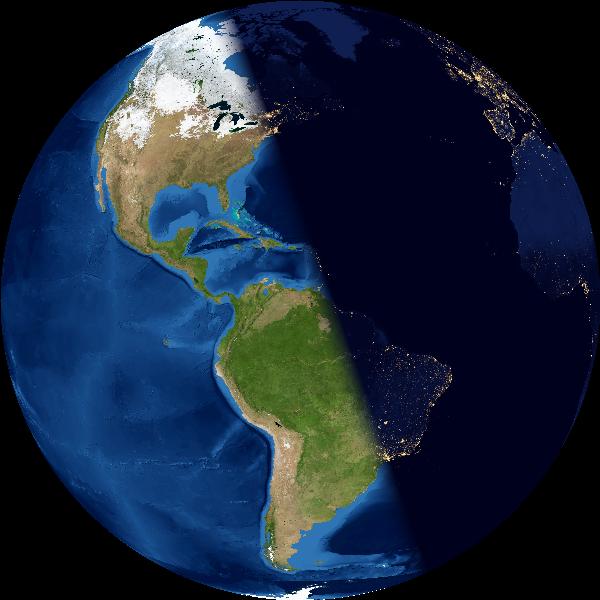
At any given moment, all the times of day occur simultaneously. While it’s early just past midnight here, it’s midday at the opposite side of the globe, while elsewhere they are watching the sunrise, somewhere else sunset. This is an example of the relative nature of time. Our experience of time varies according to where we are on Earth, not only for the times of day, but also for the seasons.
Regarding how days progress throughout the year, let’s take a closer look at a few of the Earth’s demarcation lines.
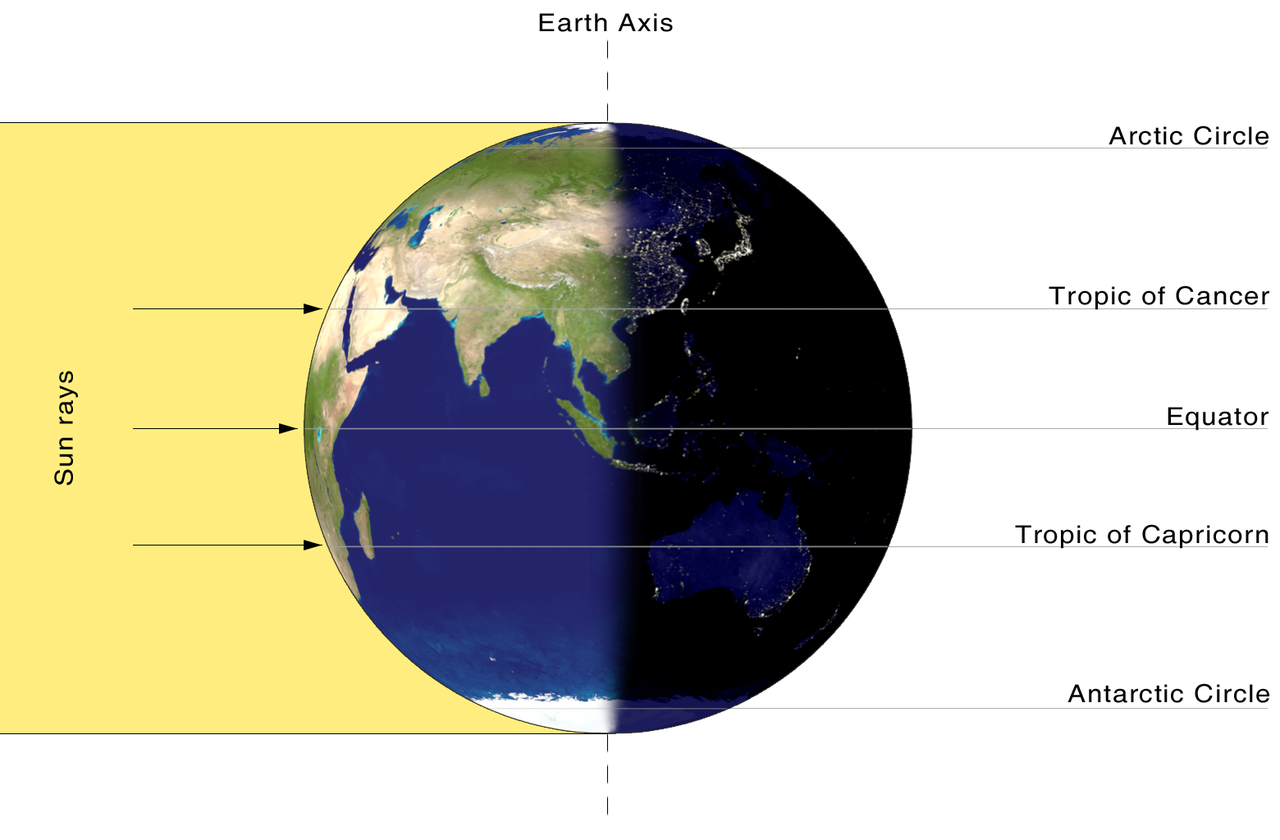
NB: The Tropics of Cancer and Capricorn have been renamed to the Northern and Southern Tropics respectively.
The lines above divide the Earth into six regions. The Equator divides the globe into Northern and Southern Hemispheres. Each Hemisphere is divided into a Tropical region between Equator and Tropic, the Hemisphere between Tropic and Polar Circle, and the Polar region. These regions are referred to as the Tropics, the Hemispheres, and the Poles.
In the Tropics, the year is fairly consistent at about 12 hours of daylight and 12 hours of night. There are two days of the year where the Sun appears to be directly overhead at noon. At the Equator, this occurs on the Equinox, at the Northern Tropic, this occurs on the Northern Solstice, at the Southern Tropic on the Southern Solstice.

In the Hemispheres, the amount of daylight relative to night changes throughout the year. This results from how the tilt of the Earth’s axis relative to the Sun exposes the Earth’s surface to light. Above, the Earth at Southern Solstice (~Dec 21) illustrates how the Southern Hemisphere receives more sunlight, and Antarctica has 24 hours of daylight.
At the Northern Solstice (~Jun 21), the Northern Hemisphere receives more sunlight and the North Pole is in 24-hours of daylight. This creates a complementary relationship between seasons. While the North is in Winter, the South is in Summer. Northern Spring coincides with Southern Autumn, Summer-Winter, and Autumn-Spring.

Population Distribution
It’s also important to keep in mind that the majority of Earth’s land mass is North of the Equator, and that the majority of people share the Northern year. It’s equally important to keep our Southern relatives in mind, as they are often overlooked when we refer to the seasons without context.
As seen in world population by latitude and longitude in the image above, the population is at its highest on either side of the Northern Tropic. The intersection of the two charts above brings us to the most populous region on Earth.
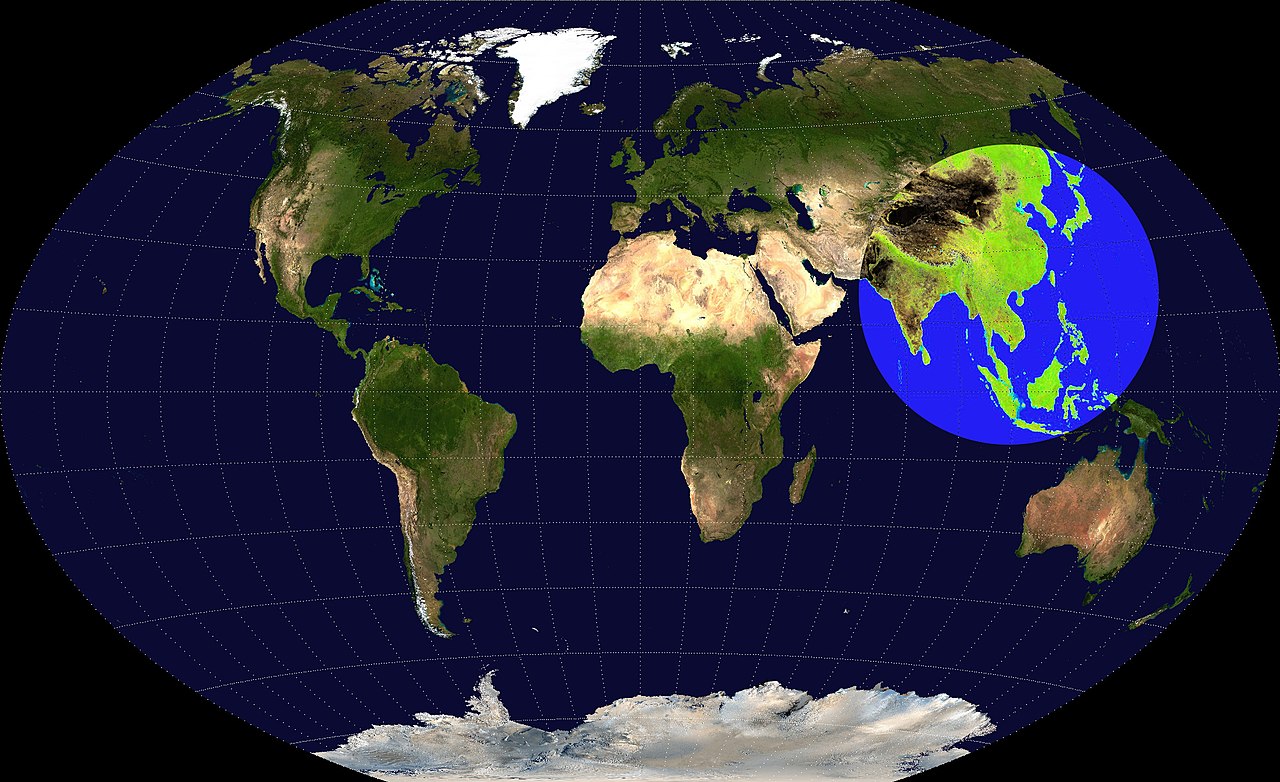
Half of the world’s population live in the region circled above. It spans the Equator and over the Northern Tropic.
It may be that Antarctica becomes a refuge from the collapsing climate, in which case, the Southern year will be essential.
Waxing and Waning Moon

The Moon, unlike the day and year, is in the same phase for everyone. Like the day and year, we define the lunar month variously. Depending on when the day begins (sunset, midnight, dawn), and where you live in the world, the phases of the Moon might be observed on one day or the next. Lunar calendars vary considerably in their details.
Regardless of the particulars, the phases of the Moon can be calculated for the next several millennia. The Moon is a fundamentally unifying rhythm, and we do ourselves great harm in excluding it from our calendar.
Simple lunar calendars are among the oldest things we have evidence of, and observing the phases of the Moon brings us back into the Natural Time our ancestors lived in (albeit a little slower).
Day & Night in Black & White
Taking a closer look at our day, Moon, and year and the changes to light that each represents, there are a number of patterns that emerge, beginning with the common elements of the night-day, new-full Moon, winter-summer.
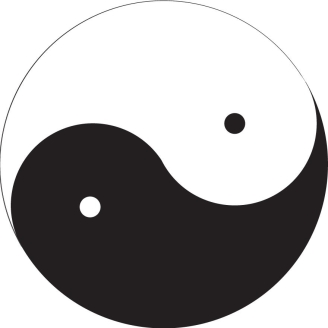
The symbol above from Daoism represents the interplay between darkness (yin) and light (Yang), While this symbol is elegant, it comes with centuries of philosophy, commentary, interpretation, and culture that is overwhelming. I’ve come up with the following to represent the interplay between darkness and light.

The waxing and waning of light and dark.
Because our idea of time is associated with motion, imagine the path of the circumference moving from darkness up to light, then back down to darkness.
365 Days by Daylight
For the sake of simplicity, I’m referring to the Year as 365 days without the need for a leap day. This is taken into consideration further along.
Because time is a local phenomenon, I had to choose an arbitrary place to use as an example. I decided on 45 degrees North Latitude, as this is halfway between the Equator and Pole, and somewhere near where I reside, which brings us to Cornwall Ontario Canada on Haudenosaunee and Wyandot territory. At Winter Solstice the 2020 Cornwallian day is 8:45:52 hours:minutes: seconds and at Summer is 15:37:11.
I shaded 365 circles in greyscale from 100% black to 100% white to represent the relative amount of daylight at Cornwall from Solstice to Solstice. I arranged these in a ring, and the result is the circle of days.

This is a map of Earth’s orbit, which is to say, a map of the year.
There are many other natural rhythms that can, and should be taken into account, however, it’s up to each community to determine what to include and what meaning to ascribe to it.
Equalnights
The word Equinox means “equal night”, however, the date when day and night are equal varies depending on where you live relative to the Equator. For Cornwall, the Equinox falls on Sep 22, whereas the equalnight falls on Sep 25.
Source: Freeman, Gordon R. Canada’s Stonehenge: Astounding Archaeological Discoveries in Canada, England, and Wales. Calgary: Kingsley Pub., 2009.
|
When Day = Night |
|
|
Date |
Latitude |
|
from Equator to N Pole |
|
|
Feb 3 – 9 |
3° N |
|
Feb 25 – 26 |
5° N |
|
Mar 7-8 |
10° N |
|
Mar 13-14 |
20° N |
|
Mar 15-16 |
30°N |
|
Mar 16-17 |
40° N |
|
Mar 17-18 |
50-80° N |
|
Mar 18 |
90° N |
|
from S Pole to Equator |
|
|
Mar 22 |
90° S |
|
Mar 22-23 |
50-80° S |
|
Mar 23-24 |
30-40° S |
|
Mar 26-27 |
20° S |
|
Mar 31-Apr 1 |
10° S |
|
Apr 14-15 |
5° S |
|
Apr 3-May 6 |
3° S |
|
from Equator to S Pole |
|
|
Aug 9-12 |
3° S |
|
Aug 28-29 |
5° S |
|
Sep 10-11 |
10° S |
|
Sep 16-17 |
20° S |
|
Sep 18-19 |
30° S |
|
Sep 19-20 |
40-60° S |
|
Sep 20-21 |
80° S |
|
Sep 20 |
90° S |
|
from N Pole to Equator |
|
|
Sep 24 |
90° N |
|
Sep 24-25 |
60-80° N |
|
Sep 25-26 |
40-50° N |
|
Sep 26-27 |
30° N |
|
Sep 29-30 |
20° N |
|
Oct 5-6 |
10° N |
|
Oct 17-18 |
5° N |
|
Nov 4-10 |
3°N |
Using these elementary rhythms, let’s start playing.
Building on Symmetry

If we draw a line from light to darkness to bisect our symbol, the two halves reflect one another. Can we do the same with Natural Time? The day divides evenly into hours, or minutes, or seconds, the Moon and year aren’t so easily divided. The Moon is reckoned as 29 or 30 days, meaning it can be divided evenly into two 15-day halves, but this only works for about half of the Moons. We can divide leap years evenly, but not regular years.
When working with odd numbers, there is an opportunity to identify the midpoint. With even numbers, then the midpoint occurs at the imaginary boundary between two days, whereas with odd numbers, the midpoint lasts a full day. We could divide the 29-day Moon into two 14-day halves with one day to mark the midpoint. Same with the 365 days of the year. We could mark a midyear day, and divide the remainder into 182-day halves. Expressing this mathematically
365 = 364 + 1 = 2 x 182 + 1
Our symmetrical year, then, looks like this:

I’ve arbitrarily set the start at Jun 22, which means the middle date falls on Dec 21. While the rest of theAbysmal Calendar system is built around these dates, it also suggests 364 other possible starting dates and midpoints.
In either Hemisphere, at Summer Solstice, the day is at its longest, and the rate of change from day to day is at its lowest. From Summer Solstice to Winter, the days grow shorter. At first, the change is very slow, maybe 1 second per day over the course of several days in Cornwall. As the year progresses, the rate of change from day-to-day accelerates, such that by the Equinox, each day is over 210 seconds shorter than the last. Then, the rate slows again, until we come around to the Winter Solstice, the shortest day, where the rate of change is 1 second per day over the course of several days.
At the second half the year, we see the same progress in reverse. The days grow longer by 1 second per day for several days, the rate accelerates to over 210 seconds per day at the Equinox, then slows again back to the Summer Solstice. The two semesters mirror each other, where one half grows darker the other half grows lighter.
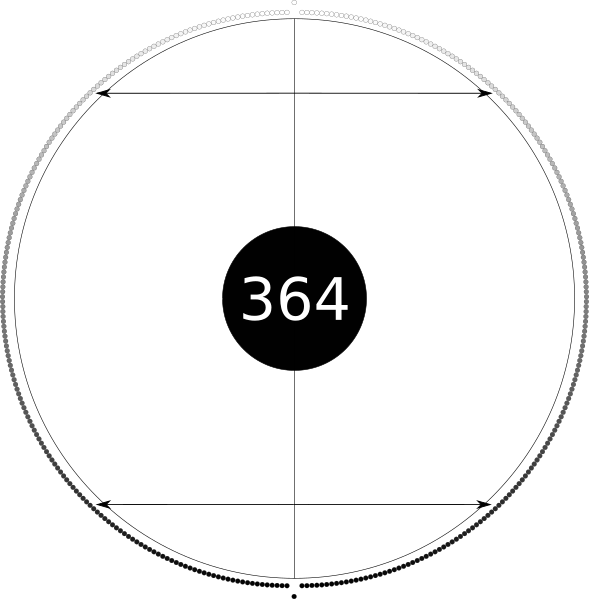
Days paired across that line have a similar amount of daylight as one another, however, one is waxing, the other waning. There are 182 pairs like this.

It’s also possible to divide the year this way, although to do so evenly means the semesters begin a day or two away from the Equinoxes. Dividing the year this way creates a dark half and a light half.
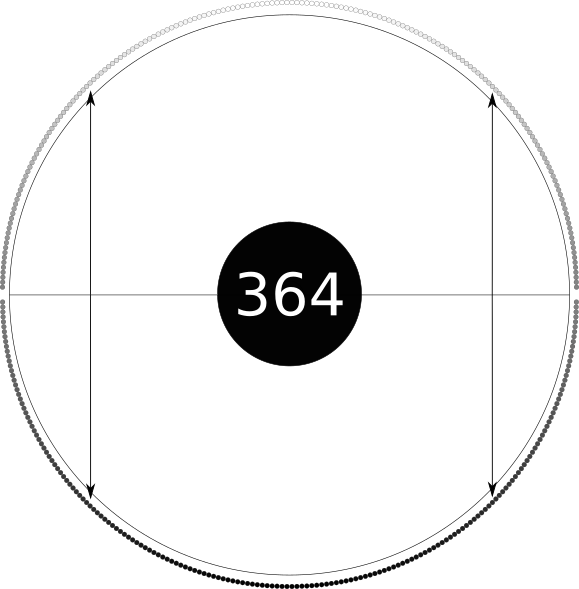 The days reflected this way have a similar rate of change, however, they have opposite proportions of day and night. In the example above, the dark days are at 10 hrs day : 14 hrs night, whereas the light days are 14 hrs day : 10 hrs night (these times are rounded off considerably).
The days reflected this way have a similar rate of change, however, they have opposite proportions of day and night. In the example above, the dark days are at 10 hrs day : 14 hrs night, whereas the light days are 14 hrs day : 10 hrs night (these times are rounded off considerably).
Because we can divide those 364 days into quarters, we can take this a step further by combining both of our divisions to get the following.

365 = 364 + 1 = 4 x 91 + 1
This provides us with four even quarters, roughly aligned with Natural Time.
This is the rhythm of our symmetrical year.
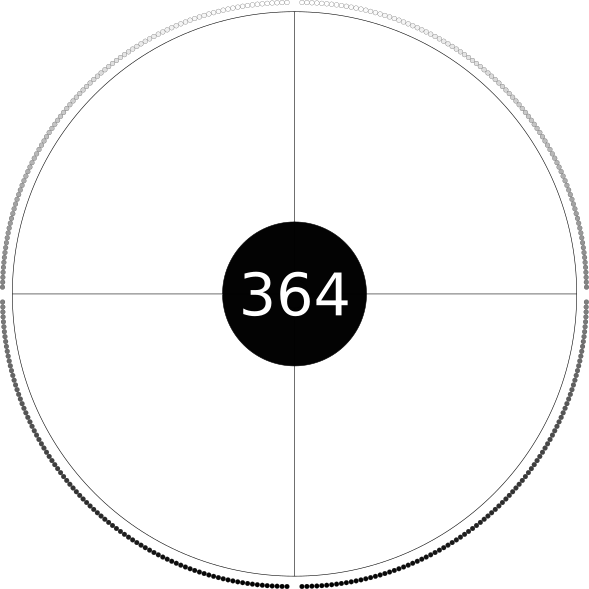
As each quarter is 91 days long, each also has a midpoint. If we begin Jun 22 and exclude Dec 21, the four midquarter days fall on Aug 6, Nov 5, Feb 5, and May 7.

We can also divide the year into quarters by using these midquarter days. This divides our year into a dark, waxing, light, and waning quarters. Also, the quarters on the left and right are the periods during which the equalnights occur: Aug 9 to Nov 10 and Feb 3 – May 6.
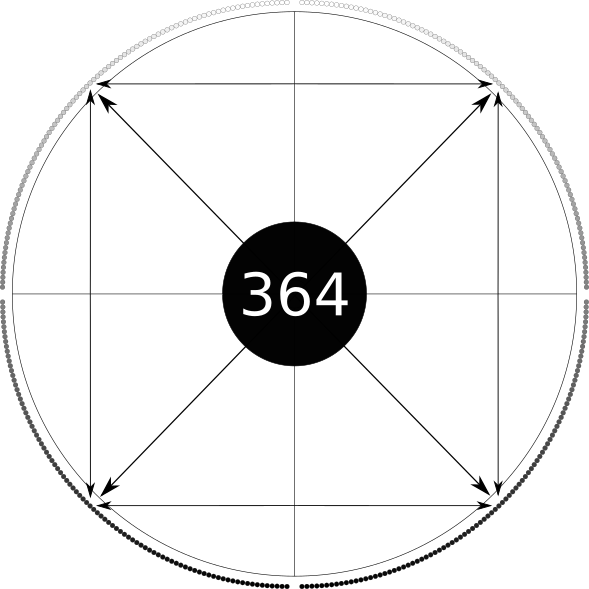
These midquarter days reflect one another across the year, and by extension, they suggest 90 more such combinations of days..

Finally, if we divide the year into eighths using these demarcations, we’ve recreated the Wheel of the Year.
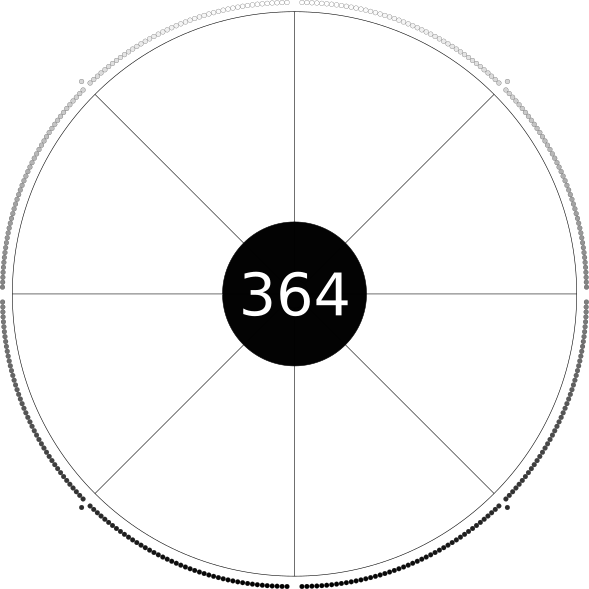
This is the basic map of the year that theAbysmal Calendar uses. There are many variations of the Wheel of the Year. I think it’s important to celebrate the actual Equinoxes, Solstices, New and Full Moons as global events in addition to holidays generated by the calendar.
Step II: dividing the solar year
Step III: weeks of the solar year
Step IV: months of the solar year
Main Page: theAbysmal Calendar
